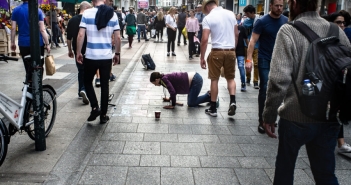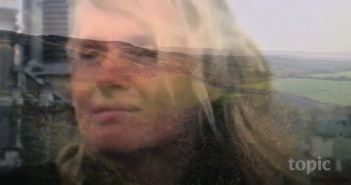In a recent review, my colleague Ben Pantrey argues Richard Kearney’s Touch is itself out of touch with the ‘maddeningly Baroque … meme-ified soup of internet discourse.’ Given the Boston-based Irish philosopher is from an older generation, a relative lack of insight is perhaps unsurprising, but in dismissing the work in at times caustic terms, the reviewer perhaps missed its central thrust.
Touch provides a compelling narrative on an intimate connection between healing and touch, pointing to a dominant tendency in Western medicine – writ large during the Covid-19 pandemic – to disregard the role of the healer, in favour of what Kearney calls a ‘model of outmanoeuvring and overcoming illness.(p.68)’
That this view now appears risqué – in the face of coercive public health – demonstrates how the argument for the type of healing that Kearney points to is being lost.
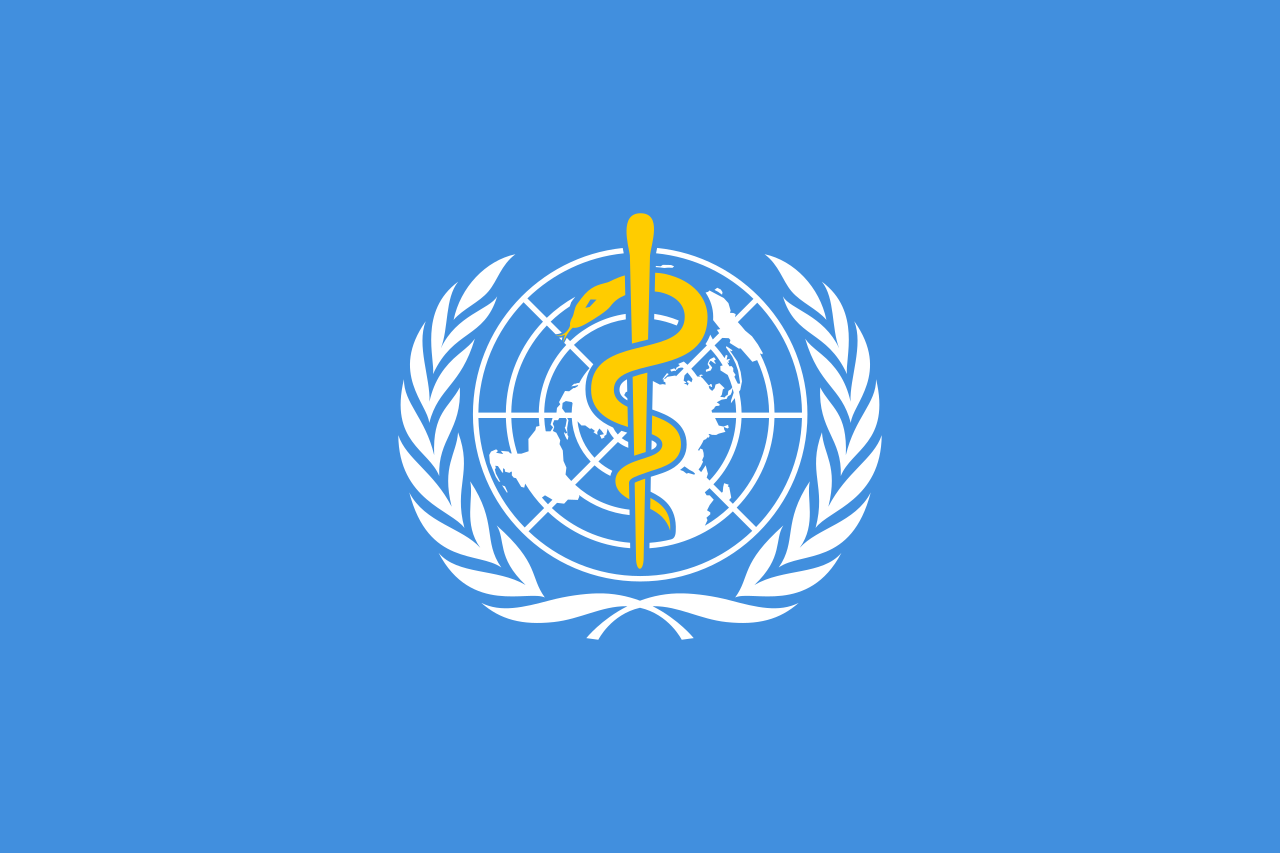
The flag of the World Health Organization, with a rod of Asclepius.
Hippocratic v. Asklepion
Kearney identifies two paradigmatic schools of medicine originating in Ancient Greece, one emanating from Chiron who taught his disciple Asclepius ‘the art of healing through touch’; and another from Hippocrates, ‘followed the way of Zeus, Chiron’s brother, who dwelt on Mount Olympus and promoted a method of optocentric supervision. (p.66)’
Following a Hippocratic approach, the patient is viewed from a distance – objectified – before the prescribed remedy, or prophylactic, is applied to an undifferentiated ‘case.’
In contrast:
Chiron comes from the word kheir, meaning hand, or, more precisely, one skilled with the hands. The related term kheirourgos means surgeon. As healer, he accompanied the art of touch – often portrayed as laying on of hands and bodily massage – with medicinal plants from the earth, music, and sleep potions. (p.66)
Asklepion healing is a two-way process that includes: ‘tactile acts of bathing, ritual massage, and the ingestion of curative herbs. (p.68)’ This sounds similar to so-called ‘alternative’ medicinal practices – dismissed as ‘unscientific’ by some doctors – and also encompasses much of the fading role of the general practitioner, where a physical presence before each distinct patient is generally considered important.
This form of healing, however, is severely compromised by exhortations – backed up by unprecedented draconian laws – to ‘socially’ distance – which is surely an oxymoron.
Kearney’s work points to profound damage that occurs when physical contact is lost, heightening a pre-existing epidemic of loneliness, which a report in 2014 found to have even worse effects on our health than obesity. The psychiatrist Iain McGilchrist goes so far as to argue that all medicine should be viewed ‘as a branch of psychiatry, and psychiatry as a branch of philosophy.’[i]
Indeed, recognising a psychological origin to physical symptoms might explain our current impasse: transfixed by the challenge of a particular virus, seemingly to the exclusion of all else. This collective hysteria suggests widespread trauma, which may be the legacy of diminished physical contact in a digitally mediated age, accelerated by what Naomi Klein described as a ‘Screen New Deal,’ rolled out under cover of lockdown.
It begs the question: what happens to society when we shrink in fear from the flesh, blood and microbes of one another? ‘Touch’, Kearney says, ‘serves as the indispensable agency of intercorporality – and by moral extension, empathy. (p.47)’

The School of Athens by Raphael.
Aristotelian Touchstone
According to Kearney, Plato’s Academy held sight to be ‘the highest sense because it was deemed the most distant and mediated.’ In contrast, according to Kearney, Aristotle, ‘makes the startling claim that human perfection is the perfection of touch, (p.35)’ writing in Metaphysics (chapter 10, 105ib, 23-25):
The being to whom logos has been given as his share is a tactile being, endowed with the finest tact.
Kearney argues convincingly that in Western medicine the Aristotlean approach, drawing on Asklepion wisdom, has been drowned out by a Platonic, ‘heroic-Hippocratic model’, which ‘only tells half the story. (p.68-69)’
In support of this thesis, in his history of the origins of the scientific discipline from the late eighteenth century, Richard Holmes has drawn attention to a delusional optimism wherein there emerged, ‘the dazzling idea of the solitary scientific ‘genius’, thirsting and reckless for knowledge, for its own sake and perhaps at any cost.’ This was the idea of a ‘Eureka’ moment: ‘the intuitive inspired instant of invention or discovery, for which no amount of preparation or preliminary analysis can really compare.’[ii]
Arguably, blind faith in dazzling scientific genius distorted public health priorities in the era of COVID-19. Lockdowns were aimed at keeping the population ‘safe’ before the invention of a ‘miraculous’ vaccine. Many seemed to assume this would act as a panacea, allowing us to awaken from the nightmare of ongoing restrictions. But a cycle of anxiety endures with the arrival of each new variant, however mild the symptoms it produces, suggesting an underlying anxiety is itself the problem.
in pursuit of a single-minded, Hippocratic “model of outmanoeuvring and overcoming illness”, morbidity and mortality from COVID-19 was inadequately weighed against the health impacts of lockdowns. According to Ari R. Joffe, the response of Western nations threatens to make ‘and likely has already made, several Sustainable Development Goals for the most vulnerable among us in low-income countries out of reach.’ The same paper also argues the ‘destabilizing effects may lead to chaotic events (e.g., riots, wars, revolutions).’

A van set on fire during the riots in Rotterdam on 26 January 2021.
Merleau-Ponty
Another philosopher Kearney cites is Maurice Merleau-Ponty who ‘took the novel step of applying the phenomenology of touch to the question of healing. (p.49)’ In response to increasing dependence on ‘optocentric’ remote diagnostics, it is worth revisiting passages Kearney quotes.
Merleau-Ponty emphasises the importance of tactility in the treatment of psychiatric illness in particular:
In treating (certain illnesses) psychological medicine does not act on the patient by making him know the origin of his illness: sometimes a touch of the hand puts a stop to the spasms and restores to the patient his speech.
Moreover,
The patient does not accept the meaning of his disturbance as revealed to him without the personal relationship formed with the doctor, or without the confidence and friendship felt towards him, and the change of existence resulting from this friendship. Neither symptom nor cure is worked out at the level of objective or positing consciousness, but below that level.
He concludes with a revolutionary idea in the context of this pandemic, where the patient-doctor relationship is side-lined in favour of generalised prescriptions, addressing one particular disease:
What this implies is that human symptoms cannot be explained by either biochemistry or intellectual volition alone – though both have their role. Ultimate healing involves an existential conversion of one body-subject in tactful communion with another. (p.49)
Moreover, Kearney adds that ‘untimely withdrawal of touch may do worse psychic damage than outright hostility or anger. (p.102)’ He refers to the findings of the Austrian doctor René Spitz in 1945, concerning an orphanage, which prevented contact between children in order to reduce a risk of them being exposed to contagious diseases, while giving them excellent nutrition and medical care. Startling, thirty-seven percent of the infants died before reaching the age of two.
Kearney also draws attention to epigenetic research demonstrating ‘key alterations in our bodies are made not just by toxins and biochemical stimulants but by the way we resonate with our fellow beings. (p.104)’
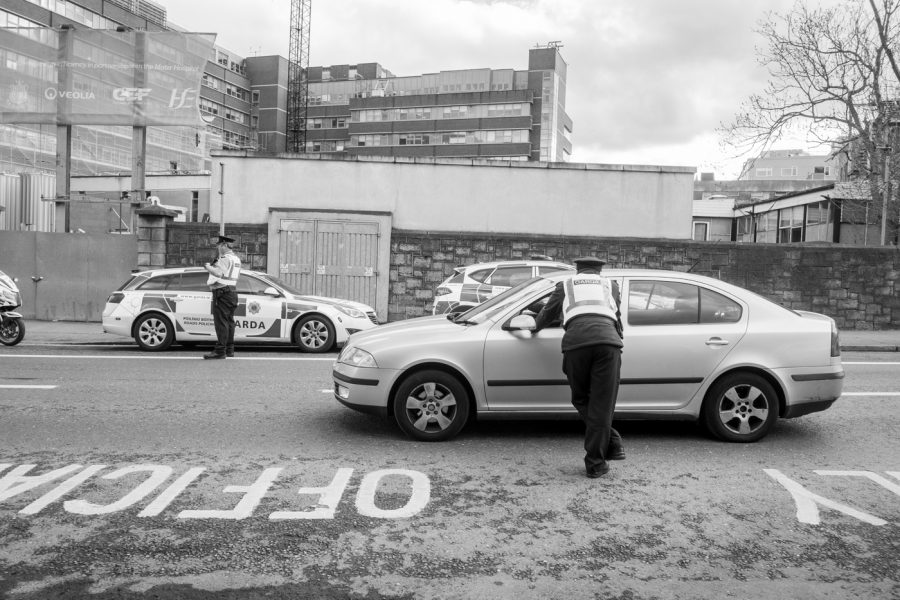
Image: Daniele Idini (c)
Responding to Covid
Given Kearney completed the book just as the COVID-19 pandemic began, his observations are of a provisional nature.
Nonetheless he makes a far-reaching claim that ‘In the first half of 2020, the virus went viral. Homo sapiens became Homo cybernens. (p.136)’ He assumes, however, an upbeat tone that now seems misplaced, saying ‘what we lost on the roundabout we won the swings’, recalling, how friends had received ‘unexpected messages from old friends and old flames (the “ex-factor”) wishing to “reconnect” at a time when physical travel and tactile contact was suddenly suspended. (p.134)’
Almost two years into the pandemic another philosopher, Byung-Chul Han has a far less rosy assessment. Writing for The Nation he describes what he calls ‘The Tiredness Virus’ in the pandemic’s wake. A triumph of sight over touch has generated what Han describes as ‘Zoom narcissism’ such that a ‘digital mirror’ encourages ‘dysmorphia’ (an exaggerated concern with supposed flaws in one’s physical appearance).
‘Digital communication is a very one-sided, attenuated affair’ Han argues, ‘There is no gaze, no body. It lacks the physical presence of the other.’ Moreover, he fears this this form of communication will become the norm, recalling all that we have lost:
The rituals we have been missing out on during the pandemic also imply physical experience. They represent forms of physical communication that create community and therefore bring happiness. Most of all, they lead us away from our egos … A physical aspect is also inherent in community as such. Digitalization weakens community cohesion insofar as it has a disembodying effect. The virus alienates us from the body.
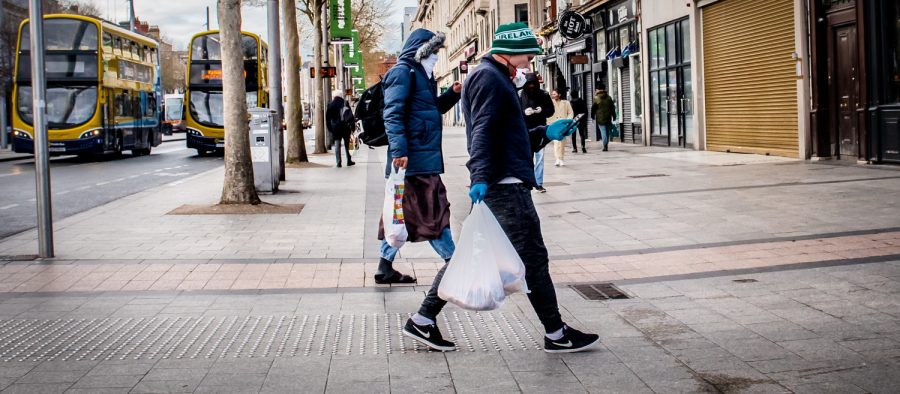
Prolonging Covid?
Could an enforced absence of touch be linked to outright pathology in the context of COVID-19?
In the U.K., on March 22nd, 2020 the Scientific Pandemic Insights Group on Behaviours, known as SPI-B., worried that ‘a substantial number of people still do not feel sufficiently personally threatened; it could be that they are reassured by the low death rate in their demographic group’; subsequently stating that: ‘the perceived level of personal threat needs to be increased among those who are complacent, using hard-hitting emotional messaging.’
In response, Professor Robert Dingwell criticised ‘this very strong message which has effectively terrorised the population into believing that this is a disease that is going to kill you.’
Is it possible that widespread conviction that a disease “is going to kill you” had unforeseen consequences in terms of adding to the burden of ‘Long Covid,’ or Covid ‘Long Haulers’ as it is referred to in the U.S.?
Long Covid is a condition fitting within the general category of a post-viral syndrome, or post-viral fatigue, which is ‘a sense of tiredness and weakness that lingers after a person has fought off a viral infection.’ which ‘can arise even after common infections, such as the flu.’ Notably, prior to the pandemic there were up to 150,000 who were already affected by ‘extreme and disabling exhaustion,’ with no apparent origin in the U.K.. Yet virtually no attention was given to this condition until the pandemic.
Moreover, in October, 2020 a leading advocates for sufferers, Professor Trish Greenhalgh clarified that Long Covid is only very rarely a long-term affliction: ‘The reviews we’ve done seem to suggest that whilst a tiny minority of people, perhaps one per cent of everyone who gets Covid-19, are still ill six months later, and whilst about a third of people aren’t better at three weeks, most people whose condition drags on are going to get better, slowly but steadily, between three weeks and three months.’
Ordinarily, one would expect public health officials to downplay such a condition, given broad acceptance that psychological stress – including a lack of touch or loneliness – is a factor in the subjective evolution or pathogenesis of most diseases. Instead, Long Covid has been widely highlighted in the media, often as a warning to young people, who might otherwise be insufficiently scared of a virus highly unlikely to kill a person under the age of fifty.
Frequent, graphic accounts, espeically via social media, may have had unintended consequences. Curiously, an informal survey of 450 people by Survivor Corps, a patient advocacy group for people with Long Covid, found that 171 said their condition improved after vaccination. That a vaccine would alleviate a post-viral syndrome is surely grounds for suspicion, hinting at a psychological origin to objective pain and suffering.
Adam Gaffney, an assistant professor in medicine at Harvard Medical School, has argued for a more critical appraisal of Long Covid. Having expressed scepticism around a condition characterised by symptoms such as ‘brain fog’, he recalls being contacted by a journalist who said: ‘I’m asking as much as a person as a journalist because I’m more terrified of this syndrome than I am of death.’
Gaffney acknowledges ‘myriad long-term effects, including physical and cognitive impairments, reduced lung function, mental health problems, and poorer quality of life’ from severe bouts of COVID-19, but cites a survey showing two-thirds of ‘long haulers’ had negative coronavirus antibody tests, and another, organised by self-identifying Long Covid patients indicating around two-thirds of those surveyed who had undergone blood testing reported negative results.
He asserted: ‘it’s highly probable that some or many long-haulers who were never diagnosed using PCR testing in the acute phase and who also have negative antibody tests are “true negatives.” In other words, for many this may be a disease with a psychological origin, which Gaffney attributes to ‘skyrocketing levels of social anguish and mental emotional distress,’ referencing a paper showing that about half of people with depression also had unexplained physical symptoms.

Getting Back in Touch
Recovery from the trauma of the pandemic should lead to a reappraisal of public health priorities. It is apparent by now that no “miracle” cure is available, decisively “outmanoeuvring and overcoming” COVID-19, and that lockdown measures, including pysch-ops instilling fear, have left deep wounds.
Works such as Kearney’s remind us of the importance of healing touch, inspired by Asclepius, which should be accorded equal importance to the Hippocratic inheritance. Now, with an ever-increasing burden of morbidity in society, particularly a veritable epidemic of mental ill-health, a paradigm shift is required.
However, Bessel Van Der Kolk describes in a recent work quoted by Kearney how mainstream medicine ‘is firmly committed to a better life through chemistry, and the fact that we can actually change our own physiology and inner equilibrium by means other than drugs, [that is]by such basic activities as breathing moving and touching … is rarely considered.’[iii]
For any shift to occur it will be necessary to confront the entrenched financial interests of the pharmaceutical industry that profits from the current model. A revealing question was posed at a medical conference in 2018 by a Goldman Sachs executive: ‘Is curing patients a sustainable business model?’
This issue could become one of the most important political questions of our time, and may lead to political realignments in the wake of a pandemic that has changed our lives.
Featured Image: A member of the Peruvian Army with a police dog enforcing curfew on 31 March 2020.
[i] Iain McGilchrist, The Master and His Emissary: The Divided Brain and the Making of the Western World, Yale University Press, New Haven/
[ii] Richard Holmes, The Age of Wonder: How the Romantic Generation Discovered the Beauty and Terror of Science (London, 2008) p. xvii
[iii] Bessel Van Der Kolk, The Body Keeps the Score, New York, Penguin, 2015, p.38.


